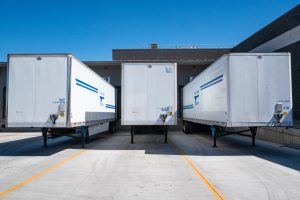
CROSS DOCKING - AN EFFECTIVE LOGISTICS SOLUTION TO BOOST COMPETITIVE ADVANTAGE
It is pivotal to improve competitive advantages and satisfy customer needs in a competitive market like logistics, Cross-docking is considered as one of the logistics strategies that can help to accomplish that milestone. Cross-docking can be defined as “to move a product from a manufacturing plant and delivers it directly to the customer with little or no material handling in between.” Also, Cross docking refers to the practice of sorting a large consignment into small consignment for multiple customers and deliver the product at common final destination to achieve economies of scale. Importance of cross-docking can be observed with the notion that Inventory tied up the cash, so it’s a managerial objective to reduce the time of inventory spend in the pipeline by quickly move the product throughout the supply chain. One strategy that helps to reduce the spending time of stock in the supply chain is considered as cross-docking.
Cross-docking helps in reducing the time of inventory by the function of mixing and sorting of shipments frequently. Cross-docking receives the delivery from an inbound dock and without storage of product directly move product to “Cross Dock” then ship from outbound transportation dock to customer. This strategy reduces the cost of the room, material handling resources and time of inventory spend in the supply chain.
HOW DOES CROSS DOCKING FUNCTION
- At the receiving dock of the warehouse, trucks that are loaded of product arrive.
- Trucks waiting on site are loaded after goods being unloaded and sorted out.
- The recently loaded trucks transport the goods to the customer.
THREE APPROACHES OF CROSS DOCKING
- Hub and Spoke
Sourcing from multiple locations in a central location called hub from where a variety of products is sorted and then directly deliver to several destinations across the globe called spoke, this approach is defined as Hub and spoke.
- Consolidation
Consolidation refers to consolidate or sort multiple small shipments into one large shipment to achieve economies of scale and reduce transportation cost.
- Break Bulking
The benefits of cross-docking are clear in the mind of supply chain participants as it reduces the cost of storage, space, and labour for handling the product. Cross-docking not only decreases material handling but also diminishes the need to store the products in the warehouse. The process of cross-docking will not suit every warehouse’s demand, it is therefore momentous for firms to take strategic decisions like whether cross-docking will increase the costs, productivity and customer satisfaction for them. If Cross docking implements correctly, then it will provide numerous advantages to the logistics management for a variety of products such as:
ADVANTAGES OF CROSS DOCKING INCLUDES:
- Reduce inventory and safety stocks.
- Reduce the cost of inventory on hand, as well as labour costs and less risk for handling inventory
- Reduce transportation and distribution cost
- Reduce warehouse cost
- Improve the flow of the material and efficiency in the network
- Decrease Lead Time
- Improve Customer Satisfaction
Nonetheless, implementing Cross Docking is not an easy task and needs a lot of consideration and preparation. Thus, what are the requirements a firm take into account before implementing a cross-docking strategy in the supply chain, is highly critical. The cross-docking implementation might look simple, but it requires some complex activities. Therefore, Five best tips are needed that should be considered before implementing a cross-docking strategy in the right way such as:
- Collaboration
Cross-docking implementation can successfully be implemented when collaboration is active with another member of the distribution chain. Clear communication, constant sharing of trusted information, and practicing give confidence in product availability and in the quality of goods which make the cross-docking experience more successful. For example with improved collaboration and accessibility of information regarding arrival, delivery, and destination of consignment, logistics participants can do planning for trucks proactively, that reduce the chances of delay in delivery of customer.
- Teaming Up
To avoid interruption in demand material flow, cross-docking operations require the best team to successfully provide the right product with the right quality and quantity that’s why before implementing cross-docking strategy, supply chain manager should take into consideration that specifications are correctly communicated to all member of the supply chain as well as to check the credibility of cross-docking strategy, formal test program must be conducted to establish the required ability which should help to meet the requirement to streamline transportation processes.
- Up To Date Technology
Cross-docking is real-time operations which depend on up to date technology, i.e. information of receiving shipments and delivering the product to a trucking company. The best way to exchange information rapidly is electronic data interchange (EDI). It helps to identify what product is on the shipment before arriving at receiving dock and provide delivery time to a trucking company on time. Thus, an up to date information is required to manage warehouse operations effectively.
4. Streamlined Transportation Processes

Before implementing cross docking approach, it is essential to examine that facility design of organisation should have the capability to handle the entire process that includes loading and unloading of shipment effectively additionally to streamline transportation process it is also indispensable for a firm to have necessary equipment available to be dealt with this approach such as warehouse management system should be implemented to internally communicate and control the operations with the help of barcoding to spend less time in tracking the items as truck arrives. Radio frequency tag, identification of sortation and merging requirement is essential to utilise the benefits of cross-docking fully.
5. Strategic management
To manage operations properly an enhanced level of strategic management is required with all equipment, and planning in the implementation of cross-docking. Because sometimes high level of dependency on technology may not be proven beneficial for example, it is possible that technology may fail and not able to work correctly, in a result it can happen that WMS may not work well, so to cope up with this barrier there should be one personal who directs the truck driver over the road and yard, which helps truck driver to reach at the right dock in a proper time and that individual will also be responsible for working around the problem with reorganising resources to maximise cross docking efficiency.
To achieve a competitive edge, supply chain needs to be cost effective along with responsive towards its customer and a firm can quickly reach that milestone by implementing a cross-docking strategy in a proper manner which requires synchronisation of inbound and outbound consignments and active collaboration and management at the cross-dock location.
AUTHOR BIO:
Sehrish Huma is a supply chain researcher and explorer. She has acquired an MS degree in Specialised Supply chain Management from the Department of Karachi University Business School at the University of Karachi, Pakistan. She has written many articles on various aspects of supply chain management like logistics management, risk management, operations management, etc. and loves to share her knowledge in the realm of the supply chain with others.
